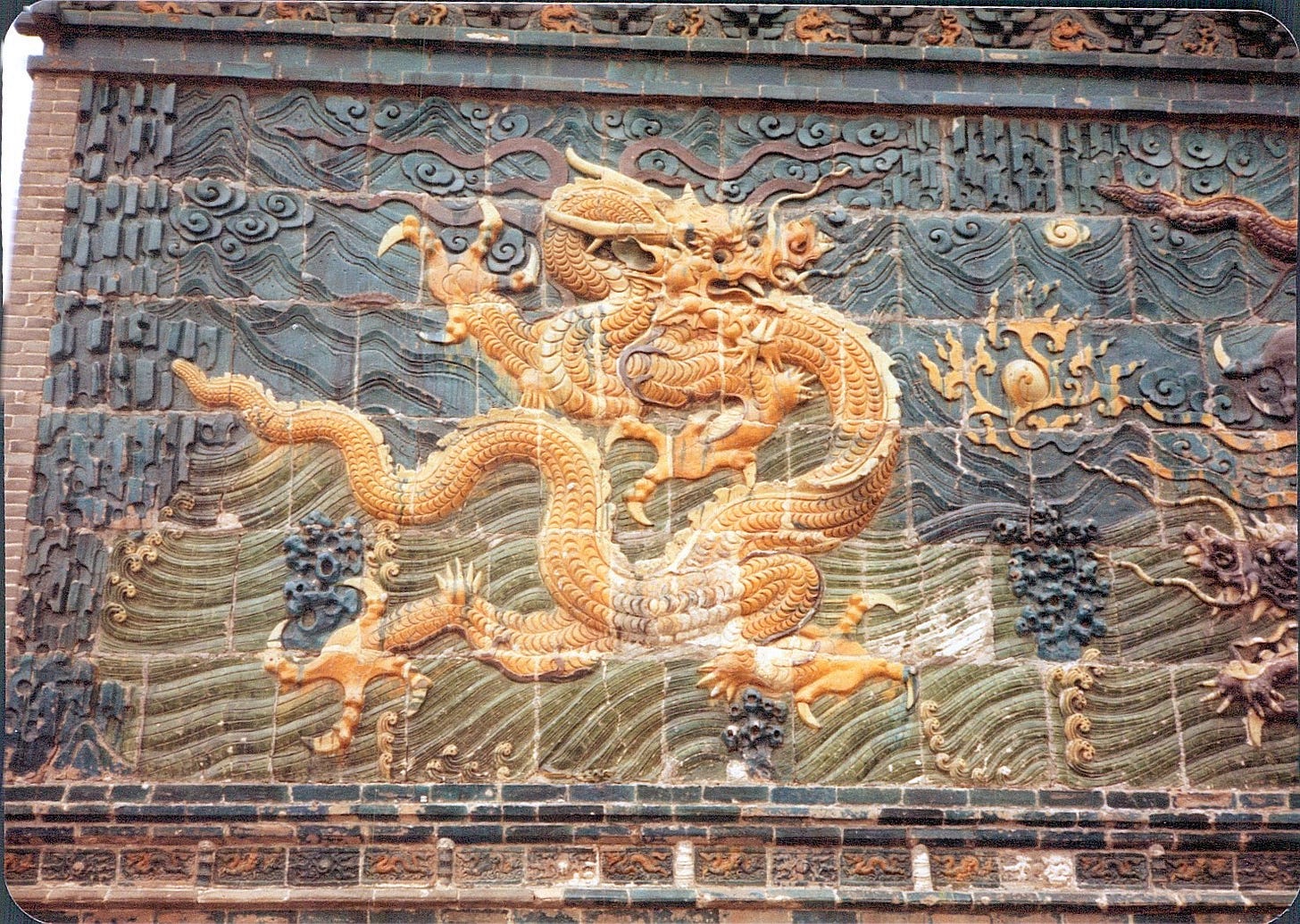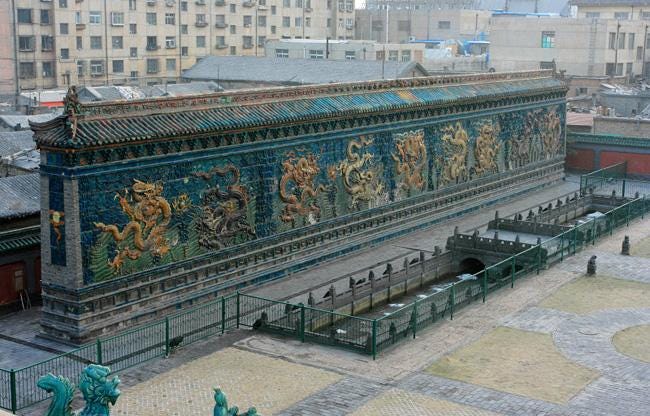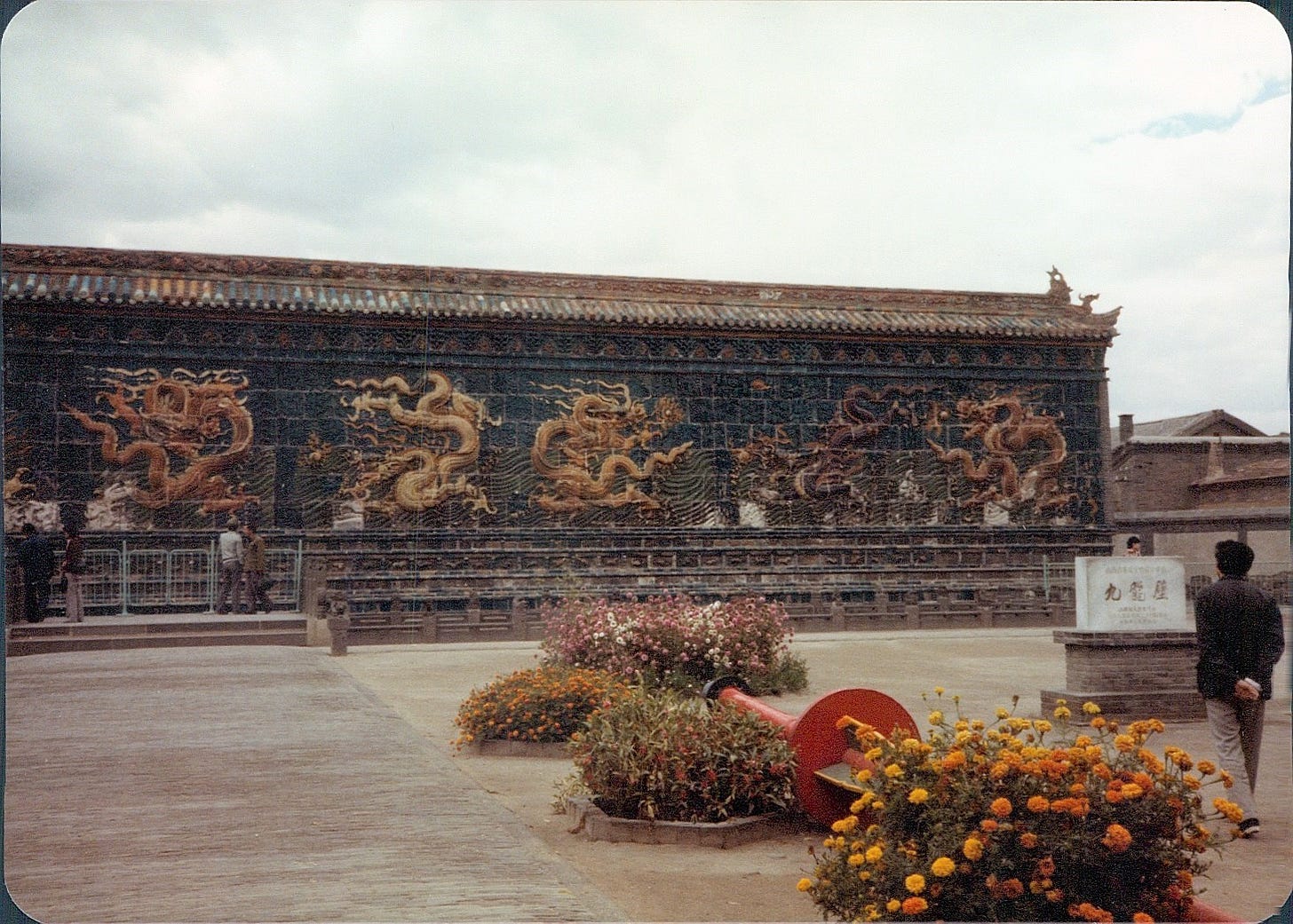The Mid-Autumn Festival, Zhongqiujie, 中秋节, was earlier this week. It falls on the fifteenth day of the eighth lunar month each year. I hope you all enjoyed this holiday that is dedicated to family togetherness. In this Issue:
People of All Shades of Same
Datong Dragon Screens
One More Thought
People of All Shades of Same
Two parts of my life intersected last week, though frankly maybe only in a way that means something to me. 😊 Let me know what you think.
First, I have been reading more on Europeans venturing into Asia during the Ming and Qing Dynasties between the fifteenth and eighteenth centuries.1
Second, I attended a Board of Directors meeting for a Healthcare for the Homeless nonprofit organization I have been involved with for many years.
If you are questioning what these two subjects could possibly have in common, I don’t blame you.
At the nonprofit meeting, we heard a presentation on the importance of promoting JEDI (Justice, Equality, Diversity, and Inclusion) in the workplace. This involves individually and collectively reviewing, recognizing, and processing how and why we act and don’t act in relation to people and groups who are different than us. Desired outcomes are to expose ourselves to other cultures and to spread awareness and understanding in order to improve our shared journey ahead.
The presentation brought to mind two statements I read recently about Ming Dynasty times, the first of which is particularly evocative:
“‘The irises of their eyes are a deep green, and their bodies as white as freshly cut lard.’”
The newcomers were intrigued by stories of earlier “‘white-skinned’ foreigners.”
Who are these “white” people who generated so much interest? You will likely not be surprised to learn that the first statement refers to the Portuguese arriving in China. On the other hand, you likely will be surprised to learn that the second statement refers to the Chinese arriving in India.
The White Portuguese. Shen Defu, 沈德符, was a writer and Ming government bureaucrat. In the early 1600’s, he wrote a book entitled, Unofficial Gleanings of the Wanli Era, 萬厲野獲編. The 16th and early 17th centuries were a time of active European maritime contact with Asia. Increasing numbers of Europeans from several countries flooded in to take control of Asian waters and establish ports far and wide. These merchants and missionaries were trying hard to gain access to China proper, among them the Portuguese who were then based in Macao. It is Shen who comments on their “white as freshly cut lard” bodies.2
The White Chinese. These Portuguese were successors to the Portuguese who were the first Europeans to arrive in Asia, on the west coast of India, more than one hundred years before beginning in the late fifteenth century. When they landed, the Europeans were intrigued by local stories of “’white-skinned’ foreigners” who had visited the Indian shores in bygone times. This must have come as a shock to the new arrivals who were certain they were blazing new trails for people like themselves.
So who were these earlier “white-skinned” visitors? The answer must have resulted in the second shock to the poor Portuguese. They learned that these earlier travelers were none other than the Chinese themselves who had arrived during the early fifteenth century.3 Those Chinese travelers were led by Admiral Zheng He, who commanded massive, Ming treasure ship fleets that made seven voyages into Southeast and South Asian waters (and further west) between 1405 and 1433.
How can the Portuguese and the Chinese both be white? Should it matter? Whether it should or not, it does. So much of life is perception. It is human nature to categorize people we meet. Stereotyping is often our default setting:
Are they like us or not like us?
Are they exotic, quaint, desirable, similar, learned, relatable, peaceful?
Are they alien, mysterious, uncouth, barbarian, uncultured, contemptible, dangerous?
Can we coexist and do business with them or should we throw up barriers?
Here is the connection in my mind between Asian travelers during the Ming Dynasty and twenty-first century Healthcare for the Homeless.
JEDI in American society is a domestic response to our well-documented and persistent history of racism and discrimination against “others” who live in our communities. The values that lie behind the drive are important domestically. Desired outcomes are to expose ourselves to other cultures and to spread awareness and understanding in order to improve our shared journey ahead.
But these values can also be seen in a broader context because as go individuals and groups in our local communities, so go nations and governments around the world.
Exposure to other cultures, spreading awareness and understanding, and learning to process and recognize how and why we respond as we do in dealing with others can hold great promise as part of a more global framework to break well-documented and cyclical histories of nation-to-nation clashes and the wars that so often occur. I understand that how we define terms and go about geopolitical relations are fraught with improbabilities and impossibilities that will never make this a complete reality. This notwithstanding, how all of us on all sides and in all locations respond to others will be recalled in the history books generations from now.
Datong Dragon Screens
To be a dragon in China is to be a powerful creature. Dragons are good omens. They are symbols of authority and strength. Dragons are protectors and bringers of wealth and good fortune. They live deep in rivers and lakes as well as high in the sky and are a connection between heaven and earth.
In Imperial times, Emperors adopted the dragon as a source and mark of power and authority. The Emperor was the Dragon Visage who rode in a Dragon Carriage and sat on the Dragon Throne. He wore dragon robes and slept in a dragon bed. When the normally four-clawed dragon has five claws instead, this Imperial dragon is the sign of the Emperor.
Images of dragons were also used on dragon screens. These screens were detached, exterior walls placed in front of Imperial residences to protect the resident from bad feng shui, evil spirits, and misfortune and to project authority to the public. There are less than a handful of Nine Dragon Screens remaining in China (the number nine is symbolic of good fortune and long life). One is in Datong.
Datong is a northern industrial city that occupies an important place in Chinese history. The famed, 1,500+ year old, Buddhist Yungang cliff carvings are located west of the city. The more than 1,000-year-old Huayuan and Shanhua Buddhist Temples are treasured sites within the city. Datong also served as a military garrison defending the empire against northern marauders. The city thus also has a proud Imperial heritage.
During the late fourteenth century, the first Ming Dynasty Emperor maintained an expansive palace in Datong. It was at that time that he commissioned a Nine Dragon Screen to be built outside the mansion for the Prince, his thirteenth son. This jiulongbi, 九龍壁, survives and is now the oldest and largest remaining such screen in China.
Rising twenty-four feet, the dragon screen stretches almost 150 feet and is six feet thick. The wall is constructed of brick and decorated with colorful, glazed ceramic tiles. Each soaring dragon is unique and symbolic of Imperial power and presents a connection between earth and heaven. A green rolling wave along the bottom half of the screen meshes with an expansive blue sky along the top half. The dragons on this screen have only four claws each because it was designed for a Prince and not the Emperor himself.
Datong actually has two extant dragon screens. The second is a Five Dragon Screen (wulongbi, 五龙壁) dating from the reign of the fourteenth Ming Dynasty emperor. This screen is twenty-three high and more than sixty-five feet long. It is now located at the grounds of the Shanhua Temple near the southern gate of the city, but was originally a screen wall protecting the Xingguo Temple outside the southern city gate.
The Nine Dragon Screen and Five Dragon Screen of Datong are wonderful connections with the past.
One More Thought
Beijing is a city on the move. Here are two short videos of China’s capital city--an eye-shaking one from the present and a slower one from the late 1980’s:
Beijing in Motion video (2021)
Beijing (1980’s)
Follow Andrew Singer on Social Media: Instagram, Facebook, Twitter.
Photo plates by Johannes Nieuhof, “An embassy from the East-India Company of the United Provinces, to the Grand Tartar Cham Emperor of China, deliver'd by their excellencies Peter de Goyer and Jacob de Keyzer, at his imperial city of Peking. London, 1673” (https://folgerpedia.folger.edu/File:141-_515f_plates_between_pg._68-69.jpg). These images are from the early Qing Dynasty.
Timothy Brook, The Troubled Empire: China in the Yuan and Ming Dynasties, Harvard UP, 2010, Page 233.
Brook, Page 225.












